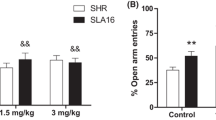Abstract
β-Phenylethylamine (PEA) is an amphetaminelike compound that is postulated to be a possible endogenous psychotogen. We studied locomotor response to PEA in two inbred progenitor strains of mice (C57BL/6 By and BALB/c By), their reciprocal F1 hybrids (B6CF1 and CB6F1), and seven recombinant inbred strains (CXBD, CXBE, CXBG, CXBH, CXBI, CXGJ, and CXBK). Univariate and multivariate statistical analyses were done. Heritability of the response to PEA was 82%. The strain distribution pattern was suggestive of the inheritance of the trait through a single major gene locus.
Similar content being viewed by others
References
Anderson TW (1958) An introduction to multivariate statistical analysis. Wiley, New York
Bailey DW (1971) Recombinant-inbred strains. Transplantation 11:325–327
Borison RL, Havdala HS, Diamond BI (1977a) Chronic phenylethylamine stereotypy in rats: A new animal model of schizophrenia? Life Sci 21:117–122
Borison RL, Reyes M, Lemus F (1977b) Regional localization of 2-phenylethylamine in human brain. Res Commun Psychiatr Behav 2:193–201
Bochme RE, Ciaranello RD (1982) Genetic control of dopamine and serotonin receptors in brain regions of inbred mice. Brain Res 21:51–65
Eleftheriou BE, Elias PK (1975) Recombinant inbred strains: A novel genetic approach for psychopharmacogenetics. In: Eleftheriou BE (ed) Psychopharmacogenetics. Plenum, New York, pp 43–71
Fink JS, Smith GP (1980) Mesolimbicocortical dopamine terminal fields are necessary for normal locomotor and investigatory exploration in rats. Brain Res 199:359–384
Jeste DV, Doongaji DR, Panjwani D, Datta M, Potkin SG, Karoum F, Thatte S, Apte JS, Wyatt RJ (1981) Cross-cultural study of a biochemical abnormality in paranoid schizophrenia. Psychiatr Res 139:341–352
Moisset B (1977a) Genetic analysis of the behavioral response to d-amphetamine in mice. Psychopharmacology 53:263–267
Moisset B (1977b) Factors contributing to the modulation of norepinephrine uptake by synaptosomes from mouse brain cortex. Brain Res 121:113–120
Nurnberger JI, Gershon ES, Simmons S, Ebert M, Kessler LR, Dibble ED, Jimerson SS, Brown GM, Gold P, Jimerson DC, Guroff J, Storch FI (1982) Behavioral, biochemical and neuroendocrine response to amphetamine in normal twins and ‘well-state’ bioplar patients. Psychoneuroendocrinology 7:163–176
Oliverio A, Eleftheriou BE, Bailey DW (1973) Exploration activity: Genetic analysis of its modification by scopolamine and amphetamine. Physiol Behav 10:893–899
Perlow MJ, Chiueh CC, Lake CR, Wyatt RJ (1980) Increased dopamine and norepinephrine concentrations in primate CSF following amphetamine and phenylethylamine administration. Brain Res 186:469–473
Potkin SG, Karoum F, Chuang L, Cannon-Spoor HE, Phillips I, Wyatt RJ (1979) Phenylethylamine in paranoid schizophrenia. Science 206:470–471
Reis DJ, Baker H, Fink JS, Joh TH (1979) A genetic control of the number of central dopamine neurons in relationship to brain organization, drug responses, and behavior. In: Usdin E, Kopin IJ, Barchas J (eds) Catecholamines: Basic and clinical frontiers, vol 1. Pergamon, New York, pp 23–33
Saavedra JM (1974) Enzymatic isotopic assay for and presence of β-phenylethylamine in brain. J Neurochem 22:211–216
Sandler M, Reynolds GP (1976) Does phenylethylamine cause schizophrenia? Lancet 1:70–71
Schoemaker H, Nickolson VJ, Kerbusch S, Crabbe JC (1984) Brain Res (in press)
Stoff DM, Gale K (1981) β-Phenylethylamine reversal of chlorpromazine-induced activation of striatal tyrosine hydroxylase and catelepsy. Brain Res 211:492–496
Wyatt RJ, Gillin JC, Stoff DM, Moja EA, Tinklenberg JR (1977) β-Phenylethylamine and the neuropsychiatric disturbances. In: Usdin E, Hamburg D, Barchas JD (eds) Neuroregulators and psychiatric disorders. Oxford University Press, New York, pp 31–45
Author information
Authors and Affiliations
Rights and permissions
About this article
Cite this article
Jeste, D.V., Stoff, D.M., Rawlings, R. et al. Pharmacogenetics of phenylethylamine: Determination of heritability and genetic transmission of locomotor effects in recombinant inbred strains of mice. Psychopharmacology 84, 537–540 (1984). https://doi.org/10.1007/BF00431462
Received:
Accepted:
Issue Date:
DOI: https://doi.org/10.1007/BF00431462




